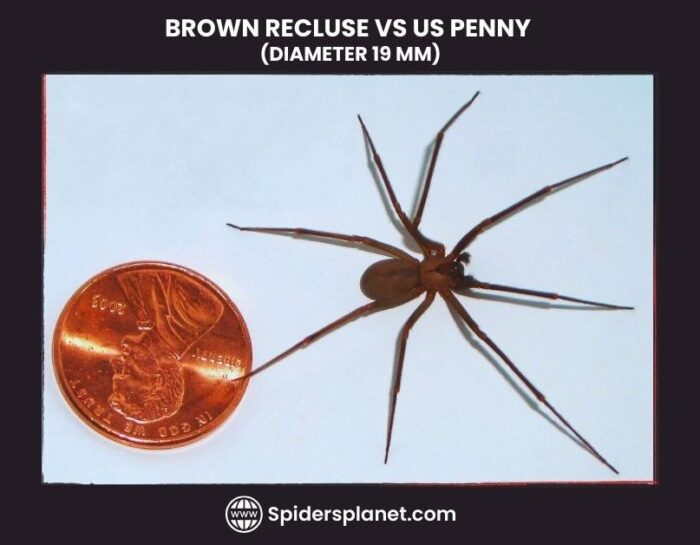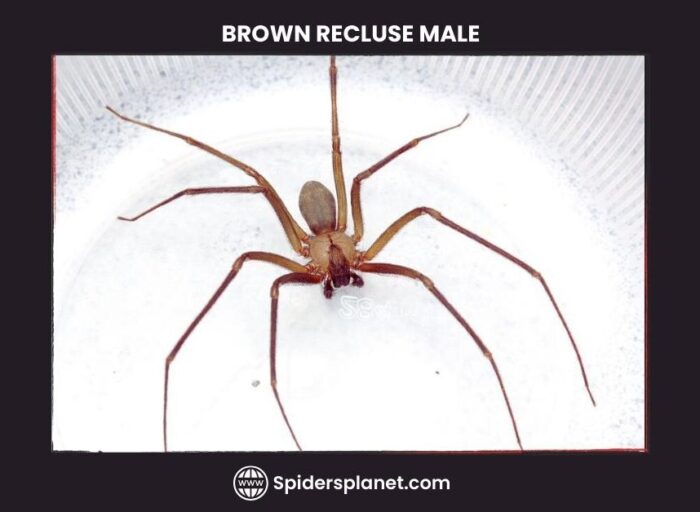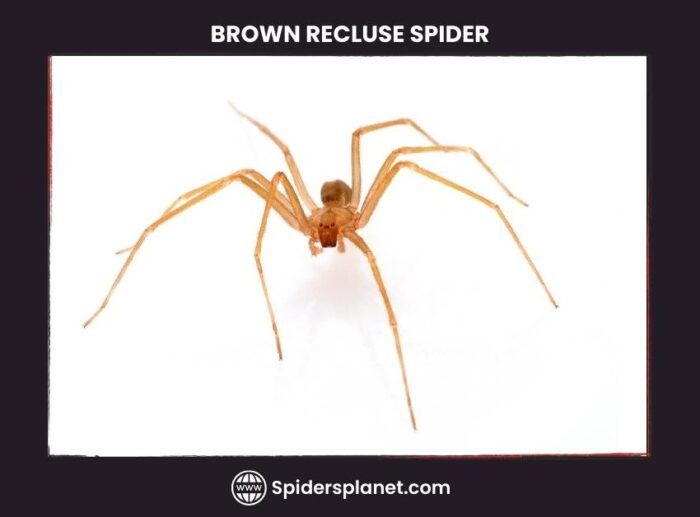The brown recluse spider, also known as the violin spider, is a venomous arachnid primarily located in the central and midwestern regions of the United States. As the name suggests, brown recluse spiders tend to be reclusive and prefer to stay out of sight.
They weave irregular webs in secluded areas, such as closets, attics, or corners of unused spaces. Although bites from brown recluse spiders are typically not fatal, they can cause significant pain and may result in serious skin damage.
It is important to note that encounters with these spiders are relatively rare, and they typically avoid human interaction unless provoked.
Understanding the characteristics and habits of the brown recluse spider can help mitigate potential risks and dispel some of the myths surrounding this intriguing arachnid.
In this comprehensive article, we will take a closer look at this mysterious eight-legged name and family, appearance, habitat, diet, venom level, and what makes them tick. Keep reading….!
Brown Recluse Spider Description:
Scientific Name, Species, and Family:
The brown recluse, scientifically known as Loxosceles reclusa, is a type of violin spider belonging to the “Loxosceles” genus, and “reclusa” is the species, while the Sicariidae family. There are more than 140 species of recluse spiders, and the brown recluse is the most widely recognized.
The brown recluse spider is classified in the Animalia kingdom, Arthropoda phylum, and Arachnida class. It belongs to the Araneae order and Araneomorphae infraorder, and This scientific classification helps us understand where the brown recluse spider fits into the broader categories of living organisms.
The brown recluse spider is often referred to as the “violin spider” due to a distinctive marking on its cephalothorax (the front part of its body, which combines the head and thorax).
The brown recluse spider bears a marking that looks like a violin, where the neck of the instrument points toward the back of the spider.
What does a Brown Recluse Spider look like?
Size and Anatomy:
Female brown recluse spiders generally have bodies that range in size from 10 to 15 millimeters, approximately 1⁄4 to 1⁄2 inch, and their leg span can extend over 25 millimeters, equivalent to 1 inch.

In comparison, males are generally about half the size of females. A noticeable characteristic in brown recluse spiders is the significant size difference between males and females.
Brown recluse spiders, akin to other arachnids, feature eight legs attached to their cephalothorax, each leg composed of segments such as femur, patella, tibia, metatarsus, and tarsus. The cephalothorax also hosts six eyes, pedipalps, and chelicerae.
Brown recluse spiders, Unlike most spiders that have eight eyes, brown recluse spiders are unique with their six eyes, organized in pairs: one pair in the center and two pairs on the sides. Their distinctive eye arrangement distinguishes them from many other spider species.
These spiders possess vital internal organs, including brains, hearts, silk glands, and spinnerets, for web production. Breathing is facilitated through specialized organs called book lungs.

Mature males exhibit enlarged pedipalps serving as reproductive organs, while females lack these and have ovaries instead. This sexual dimorphism provides a distinctive characteristic between male and female brown recluse spiders.
Color:
Brown recluse spiders come in various colors, ranging from light to medium brown; even you may find some of them in whitish, tan-brown, or blackish-gray colors. Interestingly, their front part (cephalothorax) and back part (abdomen) might not be the same color.
What makes them stand out is a special marking on the top side of their front part that looks like a violin, with a dark line resembling the neck of the violin, pointing towards the back of the spider.
The distinctive mark on brown recluse spiders has led to nicknames such as fiddleback spider, brown fiddler, or violin spider. It’s like they have a tiny musical instrument on their back!
How to Identify Brown Recluse Spiders?
Here are some key features to help you recognize brown recluse spiders:
- Violin-shaped marking: The brown recluse spider is easily identified by a distinctive violin-shaped mark on its cephalothorax, resembling a violin with the neck pointing towards the abdomen.
- Six eyes: Unlike most spiders with eight eyes, brown recluse spiders have a unique arrangement of six eyes grouped in three pairs.
- Light brown legs: Their legs are a consistent light brown color, and they lack spines, making them easily distinguishable.
- Size: Mature brown recluse spiders typically measure between 6 and 20 millimeters (0.24 and 0.79 inches) in length, with a leg span of around 25 millimeters (1 inch).
Related Post: 6 Unique Red And Blue Spiders With Photos!
Brown Recluse Spider Location & Habitat:
Brown recluse spiders (Loxosceles reclusa) are not native to Arizona. These spiders are mainly found in the United States, especially in places like Texas, Nebraska, Colorado, Arkansas, Missouri, and Oklahoma. It is very unlikely to come across them in other countries because they are mostly in these specific areas.
Brown recluse spiders do not build typical nests like some other spiders. Instead, they create irregular webs in hidden and secluded areas. These webs serve as their shelter and a place to lay their eggs.
The egg sacs, containing numerous eggs, are typically found in these webs. You can find these webs in places like woodpiles, sheds, closets, garages, and cellars, basically dry and quiet spots.
When they decide to live in homes, they like materials like cardboard, maybe because it reminds them of the natural bark they live in. People usually run into them when they accidentally disturb these hidden spots, making the spider feel threatened.
Unlike many other spiders that stay in their webs, brown recluse spiders come out at night to hunt. The males move around more when hunting, while the females stick closer to their webs.
What They Like to Eat or Hunt?
Brown recluse spiders are creatures of the night, preferring to hide during the day within the safety of their webs. However, when night falls, they venture out from their webs to hunt. In contrast to many spiders, brown recluse spiders do not use webs to catch their prey.
Instead, these spiders actively hunt for insects like flies, moths, other spiders, and crickets. Additionally, brown recluse spiders may scavenge for insects that have recently been killed, expanding their diet to include already deceased prey.
To capture and consume their prey, brown recluse spiders inject venom from their fangs, immobilizing the insects before they begin their meal.
Lifecycle of Violin Spider:
Adult or young brown recluse spiders usually live for about one to two years. From May to July, each brown recluse spider’s pregnant mommy makes several egg sacs, each holding about fifty eggs. After about a month, these eggs hatch, and it takes around one year for the baby brown recluse spiders, called spiderlings, to grow up.
Brown recluse spiders are really tough and can handle up to six months without much water or food. In a special place where people take care of them, one brown recluse even survived for more than five seasons without eating anything!
These spiders do not use a trick called ballooning to travel long distances. Sometimes, though not very often, a brown recluse might eat another spider, especially during their typical mating season from June to September or when a female spider does not want a male spider around.
Related Post: What is a Huntsman Spider? (Heteropodidae) – The Ultimate Guide
Brown Recluse Spider Egg Sac Identification:
Brown recluse spider egg sacs are crucial indicators of their presence. Typically off-white, cream, or tan, these small sacs are round or pear-shaped with a slightly fuzzy appearance. Measuring about the size of a pencil eraser, they are commonly found in dark, secluded areas like under furniture, behind baseboards, or in attics.
Brown recluse spiders may also attach their egg sacs to their cobweb-like webs or create clusters of sacs in close proximity. Identifying these sacs or brown recluse spider houses is essential for detecting a potential brown recluse spider infestation in your home.
Recluse Spider Venom and Bite:
The venomous brown recluse spider contains a mix of enzymes and toxins that can cause harm by damaging tissues and causing hemolysis, the destruction of red blood cells.

Among these toxins, the key player is sphingomyelinase D, a potent enzyme that breaks down sphingomyelin—a lipid present in cell membranes. This breakdown process can result in cell death and tissue damage, contributing to the effects of a brown recluse spider bite.
Brown recluse spider bites may not always be immediately painful, and the initial bite might go unnoticed. Nevertheless, within a few hours of being bitten, the affected area can exhibit symptoms like redness, swelling, and pain.
In severe cases, the bite may lead to tissue damage and necrosis, a condition where the skin dies, sometimes necessitating skin grafts for treatment. It’s important to be vigilant for these symptoms and seek medical attention promptly if bitten by a brown recluse spider.
Violin Spider Behavior:
The brown recluse spider has a distinct way of standing, with all legs stretched out on a flat surface. When it is alarmed, it might lower its body, pull back its front legs defensively, and get ready to lunge with its back legs. It can also stand still with raised front legs.
When threatened, it prefers to run away rather than fight, and if caught, it might spin around or even play dead. This spider does not usually jump, but if it does, it is more of a horizontal lunge than a big leap.
Interestingly, when it runs, it does not leave a silk trail behind. The brown recluse can intentionally break off its leg to escape from predators or prevent the venom from spreading.
However, unlike some spiders, it does not grow a new leg after losing one. Each time it loses a leg, it adjusts its way of walking.
Preventive Measures:
To reduce the risk of encountering brown recluse spiders and potential bites, follow these preventive measures:
- Eliminate clutter and debris in and around your home, as these spiders prefer hidden spots.
- Sealing cracks and crevices is an effective way to limit the entry points for various pests.
- Wear protective clothing while working outdoors, especially in areas where brown recluse spiders may reside.
- It is advisable to shake your clothes before putting them on to ensure there are no spiders present.
These steps create a less hospitable environment for brown recluse spiders and minimize the chances of unwanted encounters.
Related Articles:
FAQs:
How harmful is a brown recluse?
The harm from a brown recluse spider bite varies, ranging from mild redness and swelling to severe tissue damage and, rarely, death, depending on an individual’s reaction to the venom.
Why are brown recluses so aggressive?
Brown recluse spiders are not aggressive and will only bite if they feel threatened or disturbed.
Can you survive a brown recluse?
Most people survive brown recluse spider bites, but immediate medical attention is crucial for early treatment and to prevent serious complications.
How big is a brown recluse?
These spiders are relatively small, with bodies about 1/3 to 1/2 inch long, and their legs can span up to 2 inches.
How long do brown recluse spiders live?
They can live for around 2 to 4 years, during which females may lay several hundred eggs.
Final Thoughts:
The brown recluse spider, also known as the violin spider, is a venomous arachnid found in the central and midwestern United States.
Reclusive by nature, it weaves irregular webs in hidden areas, avoiding human interaction unless provoked. Although their bites are typically not lethal, they can induce significant pain and potentially lead to serious skin damage.
Understanding their unique characteristics and behaviors is crucial for identifying and managing potential risks. From their violin-shaped markings to their distinct hunting patterns, these spiders present an intriguing and enigmatic presence.




Leave a Reply